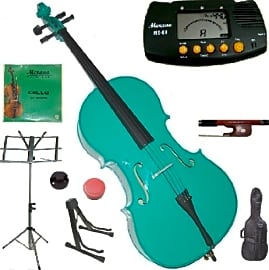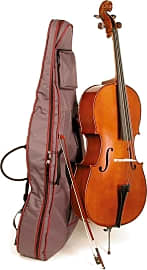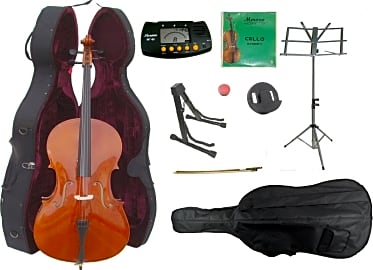The 7 Best Student Cellos

This wiki has been updated 37 times since it was first published in March of 2016. Got a budding Yo-Yo Ma or Jacqueline du Pré in the family? Then encourage his or her talent with one of these student cellos. They come in a variety of sizes to fit the height and hands of very small children all the way up to adults. We've included models priced right for beginners through to some for those who are a little more accomplished and committed to the instrument. When users buy our independently chosen editorial picks, we may earn commissions to help fund the Wiki.
Editor's Notes
February 13, 2020:
In a very slow-moving category, we only found it necessary to place the Merano 3/4 Size Green in our ranking in the spot previously held by the company's blue mode, mainly for availability reasons. We also found an additional offering, the Stento 1108 4/4, which is an excellent full-size model for its price, wth a lightweight case and instrument blanket included.
That sizing issue continues to be one of the primary means by which we organize this list (in addition to package contents like tuners and cases), as the size you'll need will correspond pretty directly to the size of the student. A qualitative difference with respect to price and size is perhaps most evident in comparing the D Z Strad 101 with the Cremona SC-175 Premier 3/4. The D Z models come in around the same price as the Cremonas, but the overall quality for the dollar amount in the D Zs is a little higher, with hand-carved elements that add both character and reliability to the instrument.
A Brief History Of The Cello
There was wide variation among these early cellos, with many being made from bass violins that were simply cut down in size.
Prior to the Renaissance, most musical instruments were designed solely to accompany singing or dancing. Instruments like lyres, harps, and trumpets were commonly used, but they were expected to enhance a performance rather than to stand out on their own.
By the 15th century, however, instruments were being developed that could shine on their own merits in a solo performance. The violin was one of the first of these pieces to come along, gaining great popularity in Italy among street performers and nobility alike.
Soon, there were three sizes to choose from: violins, violas, and violincellos. The latter of these, eventually known simply as the cello, was initially intended to accompany and accentuate the violin for bass and harmony. Indeed, there were few pieces written for the cello in the beginning, and those that did exist were largely violin pieces transposed down an octave.
In Bologna in the 1660s, wire-wound strings were developed, which gave the cello a finer bass sound than the gut strings that were used previously. As a result, composers begin to write pieces specifically for the instrument. Johann Sebastian Bach's six unaccompanied suites, penned sometime before 1720, were the first groundbreaking compositions designed for the cello, although they wouldn't receive widespread recognition until the early 20th century.
There was wide variation among these early cellos, with many being made from bass violins that were simply cut down in size. It wasn't until Antonio Stradivari standardized the design of the instrument in the mid-18th century that it began to take on the shape we associate with it today.
However, there was still some tinkering with the design, with the end goal to change the sound to play better in large spaces. Previously, it was intended to create delicate tunes suitable for an immediate audience, but larger concert halls and a focus on individual performance required more volume and fullness. To that end, the neck and fingerboard were extended, while the bridge was raised to place more pressure on the strings.
Today, the cello is one of the classical instruments held in the highest esteem, with virtuosos like Yo-Yo Ma and Mischa Maisky playing to packed halls across the world. It's even found its way into a diverse range of genres, with cello rock enjoying an especially devoted following.
How To Buy A Student Cello
The good news about buying a student cello is that they're often much less expensive than their advanced counterparts. In fact, you likely shouldn't spend too much money on a student cello, due to the wide range of uncertainty surrounding the instrument, such as how roughly it will be treated, how often it will be used, and whether the student will even want to keep playing in the future.
The size of the cello is going to be the first factor to take into consideration.
That's why most student cellos are machine-made and mass-produced. This keeps costs down, but it also affects the quality. That's okay; a student likely isn't going to be able to play the instrument well enough for you to notice the difference. These are for learning, and so making mistakes and doling out abuse is to be expected. You can always get a higher-quality model once you're ready for it, but think of this cello as the beater car you learn on before buying that BMW.
The size of the cello is going to be the first factor to take into consideration. If the player is at least five feet tall (or will be soon), a full-sized cello should be fine. However, any shorter than that and a 3/4- or 1/2-sized model will be a better fit. Larger cellos produce better tone, but again, this likely won't be a big deal for the beginner.
You should still try your cello on for size if possible, however. Be sure to sit straight in your chair, play a variety of pieces, and hit all the strings in all registers — basically, try to replicate a concert experience. If you find the unit uncomfortably too large or too small, don't be bashful about sending it back for another.
The most important thing is to find something that you'll be comfortable practicing with, as you can expect to get very well-acquainted with it indeed. Don't necessarily worry about things like high-end sound or durability (beyond any extremes, of course). By the time you've outgrown this model, you'll be ready to move on to a better one that will last longer and sound better.
And if after all that practice you decide that you'd rather play the guitar instead, well, at least you won't be out too much money.
How To Care For Your Cello
While a student cello isn't likely to be as delicate as one painstakingly made by a talented craftsman, that doesn't mean that you should be careless with it.
Also, if you find that you often need to break your cello over someone's head in a bar fight, book better gigs.
Keeping it safe is your first priority. It doesn't necessarily need to be in its case at all times — and putting it in there frequently can increase the likelihood of scratching it — but keep it somewhere it will be safe, away from rambunctious pets or children. A cello stand in a quiet room is a great spot.
It's also good to dust it at least once a week. You can just use a damp cloth for this, or a small dab of specially-made cello polish. Your strings should be cleaned once a month or so, using a cloth with a little alcohol on it. Try not to touch the cello itself with the rag, though, as the alcohol will eat through the varnish.
Be gentle when carrying your instrument, and be sure to hold it by the neck. Never lay it bridge-down, and try not to bump it against anything. Also, if you find that you often need to break your cello over someone's head in a bar fight, book better gigs.
Cellos are delicate creatures, as would befit an instrument capable of making such beautiful music. Still, with a little TLC, your cello should provide you years of enjoyment.












